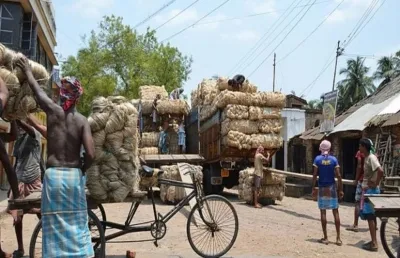Has the Centre Revived Bengal's Jute Industry?

Synopsis
Key Takeaways
- Bengal's jute industry is witnessing a revival due to government interventions.
- Record prices of jute are benefiting local farmers.
- Over 4 million people are employed in the jute sector.
- Strategic restrictions on imports protect local farmers' incomes.
- The jute industry is vital for rural livelihoods in West Bengal.
New Delhi, Oct 4 (NationPress) After many years of downturn, Bengal's renowned jute industry is experiencing a rebirth. Previously afflicted by poor profits, mill shutdowns, and farmer distress, the sector is once again thriving due to the prompt and strategic actions taken by the Central Government under Prime Minister Narendra Modi, as stated by BJP IT Cell chief Amit Malviya on Saturday.
Malviya, who oversees West Bengal for the BJP, mentioned that the strategic restrictions on jute imports from Bangladesh have renewed confidence among local farmers.
With ample rainfall and innovative policy support, the industry has seen improved yields, enhanced fibre quality, and record prices reaching Rs 8,800 per quintal this season, nearly doubling from the previous year, he highlighted.
“The golden era of jute is upon us again — all thanks to the forward-thinking policies of the Narendra Modi Government,” Malviya stated.
More than 4 million people in Bengal are currently benefiting from increased employment opportunities and timely payments in the labour-intensive jute sector, he added.
Malviya also praised the contributions of the National Jute Board and Union Minister Giriraj Singh for their tireless efforts in revitalizing this heritage crop and instilling new hope in Bengal's farmers.
“This is Modi Sarkar's Atmanirbhar Bharat in action — empowering farmers, bolstering rural livelihoods, and restoring dignity to one of Bengal's most historic crops,” Malviya remarked.
The Indian jute industry plays a vital role in sustaining rural livelihoods, particularly in West Bengal, which alone contributes to 78 percent of national production. Raw jute is primarily cultivated in West Bengal, Bihar, Assam, Orissa, Andhra Pradesh, Tripura, and Meghalaya.
It is estimated that the jute sector directly employs over 4 lakh workers in organized mills and diversified units, including tertiary sectors and related activities, providing livelihoods for several lakh farming families.
Additionally, many individuals are involved in jute trade. Nearly 90 percent of India’s jute production is consumed domestically, mostly procured by the Government of India. The artificially low prices caused by subsidized imports from Bangladesh have previously negatively affected jute farmers' incomes.
The Centre has enacted port restrictions on the import of jute and related fibre products from Bangladesh to curb the influx of cheap, subsidized imports from the neighboring country, which have depressed prices, harmed farmers' earnings, and led to underutilized capacity in Indian jute mills resulting in closures and unemployment.
These restrictions aim to combat unfair trade practices, promote Atmanirbhar Bharat, and safeguard rural livelihoods connected to India’s domestic jute economy. The Government is also implementing measures to ensure that imports from Bangladesh are not redirected through third countries, circumventing the restrictions, as per an official statement.









